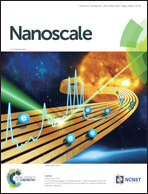Ensemble averaged structure–function relationship for nanocrystals: effective superparamagnetic Fe clusters with catalytically active Pt skin†
Abstract
Practical applications require the production and usage of metallic nanocrystals (NCs) in large ensembles. Besides, due to their cluster−bulk solid duality, metallic NCs exhibit a large degree of structural diversity. This poses the question as to what atomic-scale basis is to be used when the structure–function relationship for metallic NCs is to be quantified precisely. We address the question by studying bi-functional Fe core−Pt skin type NCs optimized for practical applications. In particular, the cluster-like Fe core and skin-like Pt surface of the NCs exhibit superparamagnetic properties and a superb catalytic activity for the oxygen reduction reaction, respectively. We determine the atomic-scale structure of the NCs by non-traditional resonant high-energy X-ray diffraction coupled to atomic pair distribution function analysis. Using the experimental structure data we explain the observed magnetic and catalytic behavior of the NCs in a quantitative manner. Thus we demonstrate that NC ensemble-averaged 3D positions of atoms obtained by advanced X-ray scattering techniques are a very proper basis for not only establishing but also quantifying the structure–function relationship for the increasingly complex metallic NCs explored for practical applications.



 Please wait while we load your content...
Please wait while we load your content...